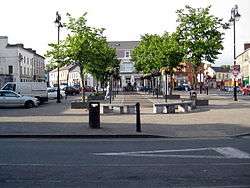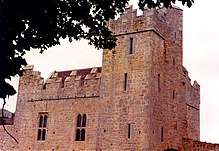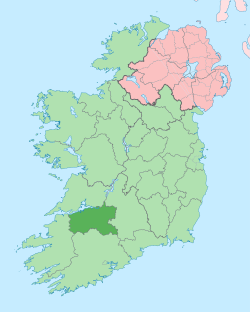Newcastle West
Newcastle West (Irish: an Caisleán Nua Thiar) or simply Newcastle (an Caisleán Nua, formerly anglicized Castlenoe) is a town in west County Limerick, Ireland. It is the largest town in the county, excluding Limerick city, and sits on the River Arra which flows into the River Deel. Newcastle West is in the middle of a great bowl-shaped valley in West Limerick, known one time as the valley of the Wild Boar, apparently due to the abundance of this animal here when the area was thickly wooded. The crest of the town carries the image of a wild boar. Newcastle West is on the N21 road from Limerick to Tralee, between Rathkeale and Abbeyfeale. In 2016, the population of the town was 6,619.[1]
Newcastle West an Caisleán Nua Thiar | |
|---|---|
Town | |
 The Square | |
 Newcastle West Location in Ireland | |
| Coordinates: 52.451°N 9.055°W | |
| Country | Ireland |
| Province | Munster |
| County | County Limerick |
| Limerick County Council LEA | Newcastle |
| Dáil Éireann Constituency | Limerick County |
| EU Parliament | South |
| Elevation | 55 m (180 ft) |
| Population (2016)[1] | |
| • Total | 6,619 |
| Irish Grid Reference | R282336 |
History
Foundation and development
Newcastle West grew up around a castle, the ruins of which are located off the town square. The large castle ruins are well maintained.
The castle was built by the FitzGerald family who arrived at some point after 1194, by 1298 the castle had been completed in stone. The town then came to be known as Newcastle, West Limerick, but over time the 'west' became part of Newcastle and the town was known by the current name Newcastle West.
According to Begley,[2] the parish was called Newcastle and Ardagh in 1704. Newcastle was joined with Monagea from 1722 until 1764 when it became a separate parish. Lewis stated that parts of Monagea and Killeedy were in the parish of Newcastle West.
Two notable mentions included in the history of the diocese of Limerick were the first Monsignor in the diocese, Richard Baptist O'Brien in 1881, and Denis Hallinan who was P.P. here and later became Bishop.
Sir William Courtenay, the local landlord, held 10,500 acres (42 km2) of land in Newcastle West in the late 16th century. He was a staunch Catholic, and suffered persecution for his beliefs. His son George may have practiced his faith in secret. Their home was reputed to have had a room in which priests were hidden. William Courtenay was denounced in the House of Commons as a papist recusant in 1624.
During the reign of Elizabeth I, three battles were fought near here. Tradition has it that the locals killed many of the Knights Templar. The town was sacked in 1302 and destroyed in 1315. Two of the Earls of Desmond died here. Garrett (better known as Gearóid Iarla) in 1399, and James, the 8th earl, in 1462.
Markets were held on Tuesday, Thursday, and Saturday. Large numbers used to attend Thursday's hiring fairs for farm workers. Fairs were held on April 1, May 3, July 12, August 20, October 1, and December 10.
The motto that goes with the town coat of arms is "As Dúchas Dóchas", which may be translated as 'Our Hope springs from our Traditions'. The town now has a population of around 6,600.[1] The urban area has passed well beyond the old town boundaries which are due for redefinition.
2008 flooding
On 1 August 2008, up to 20 homes were badly affected by overnight flash flooding in Newcastle West, in an incident described as a 'freak' occurrence. A number of people had to be rescued from their houses after the River Arra burst it banks following heavy rain. There were few injuries, however an elderly woman was taken to hospital after she was airlifted from her home suffering from hypothermia. 3,000 homes in Newcastle West temporarily lost power. The Killarney Road (N21) was temporarily closed as was the R522 to Dromcolliher and the Bruff line.[3]
Business and commerce
The West Limerick and Newcastle West area has traditionally had a strong dairy and agricultural contribution to the local economy. Huge changes have occurred during the last 20 – 30 years seeing the expanding of the town as a services centre for West Limerick, also bringing an increase in population. Many people who work in Limerick City live in Newcastle West and its environs and commute the 42 kilometres (26 mi) daily. However, Newcastle West itself is now a large centre of employment itself. Employers include Pallas Foods, Rettig Myson, Ballygowan Spring Water and Filtertek. There are dozens of businesses employing 10-50 including PSE Power Systems, Brian A Flynn, Brian Scully Services and Nolan Products. Hundreds are employed in the retail stores including local and international multiples. In recent times, there has been national success stories in e-business from local companies like HuntOffice.ie.[4] and IrishTourism.com,[5]
Retail outlets and supermarkets in the area include Dooley's SuperValu, a Tesco, an Aldi, and a Lidl. The town is also has a number of clothes shops and fashion boutiques.[6]
Education
Newcastle West has three primary schools: Courtenay Boys' School, Scoil Iosaf (an all girls school), and Gaelscoil O'Doghair (an Irish language school). The town also has three secondary schools, named Scoil Mhuire Agus Ide (English translation: the School of Mary and Ita), Desmond College and Gaelcholáiste Uí Chonba ( All Irish Second level school on the grounds of Desmond College).
Transport
Newcastle West is situated on the Irish national primary road N21, where it is joined by the R520, R521 and R522 regional roads. Newcastle West is forty minutes drive from Limerick City and an hour from Killarney. It is within a one hour drive of Shannon, and Kerry International Airports, and two hours from Cork Airport.
The town is serviced by regular Bus Éireann buses and Dublin Coaches[7] to Tralee, Killarney, Limerick and Dublin.
The town was connected to the railway network until 1975, as part of the "North Kerry" line, from Limerick city to Tralee, via Rathkeale and Listowel. Newcastle West railway station was on Bishop Street and opened on 1 January 1857. It closed for passenger traffic on 4 February 1963, regular goods traffic on 2 December 1974 and finally closed on 3 November 1975, although occasional passenger special trains, diesel and steam hauled, had operated into the 1970s.[8] The station had an unusual layout, with two turntables and water columns for steam locomotives, the result of the lines from the Rathkeale and Abbeyfeale directions having been built by different companies. After the tracks were lifted in the late 1980s, in 1999, the former station house was restored as a private house within the Bishop Court development of the station area. The Great Southern Trail walking and cycling route follows the line of the railway, passing the site of the demolished twin arch road bridge which spanned the lines to Rathkeale/Limerick and Abbeyfeale/Tralee just before they diverged.
Sport
Newcastle West is home to numerous sports clubs, including Newcastle West GAA club, Newcastle West Rugby Football club,[9] and had two association football clubs: Newcastle West A.F.C. and Newcastle West Rovers F.C., which amalgamated in 2018 to form Newcastle West Town AFC.
Places of interest
Buildings, bridges, parks
- The Square

- Desmond Banqueting Hall and Castle - Newcastle West's landmark feature dominates the southern of end of the Main Town Square. The banqueting hall of the Desmond Castle, seat of the Earl of Desmond, parts of which date from the 13th century, is the most notable historical feature of the town. The current Castle dates from the 15th century and during the later part of the 20th century was partly restored and is open to the public, for guided tours May to September. The guided tour is a must for locals and visitors. The area in front of the banqueting hall was the site of The Protestant Church, built in 1777.
- Castle Demesne - Over 0.4 square kilometres (99 acres) of parkland with numerous forms of flora and fauna as well as playing areas and sports fields.
- Slí na Sláinte - Walking trails which includes the Square and the Demesne.
- Great Southern Trail - A walking trail developed along the disused railway line. It offers an interesting scenic walk between Newcastle West and Rathkeale or Newcastle West and Abbeyfeale, via Barna and Templeglantine.[10]
- Churchtown Graveyard and Grotto - The Old Church Ruins in Churchtown (Catholic) date back hundreds of years.
- Old IRA Monument - situated opposite the church this monument commemorates 17 volunteers who were killed during the war of independence and Civil War 1916 - 1922. The monument was unveiled by President Sean T.O'Kelly in 1955.
- Church of the Immaculate Conception (Catholic) - built in 1828 by Father Thomas Coll P.P. The local Landlord, the Earl of Devon gave the site with the parishioners providing voluntary labour in the building work.
- Iron Footbridge - crossing over the river Arra the bridge is located opposite the church and was erected by Edward Curling, the Landlord's agent in Newcastle West from 1848 - 1874.
- Famine Graveyard - located at the rear of St. Ita's Hospital. Many hundreds of people who died in the work house during the famine are buried there in unmarked graves. The cemetery is marked by a plain old cross and modern, limestone gates sculptured by Cliodna Cussen, showing scenes from the famine and commissioned by the Famine Cemetery Committee.
- St. Bridget's Well - located in Shanagarry on the Killarney Road.
- Carnegie Library - located in the Market Yard this impressive building was built by the Carnegie Trust and founded by the Scottish / philanthropist Andrew Carnegie. The building housed a secondary school for many years. It is now a busy commercial centre.
- Bridge of Tears - located at the south of the town at the junction of the Cork Road and Bruff Line, there is a stone bridge which takes its name from being a famous last farewell point. Known locally as the Bridge of Sorrows or Tears, during the time of the famine, Emigrants from all over West Limerick said their last goodbyes before walking or taking a carriage to Cork and the boat to North America or further.
- Barnagh Gap - About 7 kilometres west of the town is the scenic view point at Barnagh Gap, which provides a panoramic east facing view over County Limerick, West Tipperary/ Galtee Mountains and north County Cork. On a clear day North tipperary and Clare are also visible.
Great Southern Trail Ireland
The Great Southern Trail is a 53-mile (85 km) stretch of countryside in West Limerick/North Kerry. It is the route taken by the former Limerick - Tralee railway line, which opened in 1867/1880 and closed in 1975/1977. The Great Southern Trail Action Group are a non-profit group working to develop the Limerick to Tralee section as a rail trail. The group is based around the Newcastle West area.[11]
Surrounding area
Ardagh, Dromcollogher, Broadford, Carrigkerry, Monagea, Kilmeedy, Castlemahon, Feenagh, Ballingarry, Knockaderry, Feohanagh, Strand, Killeedy, Ashford and Raheenagh are all villages within 10 miles of Newcastle West.
Notable people
- Michael Hartnett, poet
- Philomena Lee, subject of "The Lost Child of Philomena Lee" by Martin Sixsmith.
- John St. John Long, notorious quack
- Max Arthur Macauliffe, civil servant and scholar
- William Nash, recipient of the Victoria Cross.
- John Wolfe Ambrose, native son who went on to become famed New York City civil engineer
See also
- List of towns and villages in Ireland
- Market Houses in Ireland
- Newcastlewest Stage & Musical Society (aka Newcastlewest Musical Society) - Founded 2009
| Wikimedia Commons has media related to Newcastle West. |
References
- "Sapmap Area - Settlements - Newcastle West". Census 2016. CSO. 2016. Retrieved 12 January 2018.
- ?
- Boil notice issued after Limerick floods
- Who are HuntOffice.ie at HuntOffice.ie Website
- IrishTourism.com
- http://visitnewcastlewest.ie/fashion/
- http://www.dublincoach.ie/timetables-fares/M7-bus-ennis-tralee-killarney-limerick-dublin-city.php
- "Newcastle West station" (PDF). Railscot - Irish Railways. Retrieved 2007-11-19.
- http://www.newcastlewestrfc.com/
- http://southerntrail.net/maps/walking%20ireland%206.8.13.pdf
- http://www.thejournal.ie/great-southern-cycleway-805836-Feb2013/
